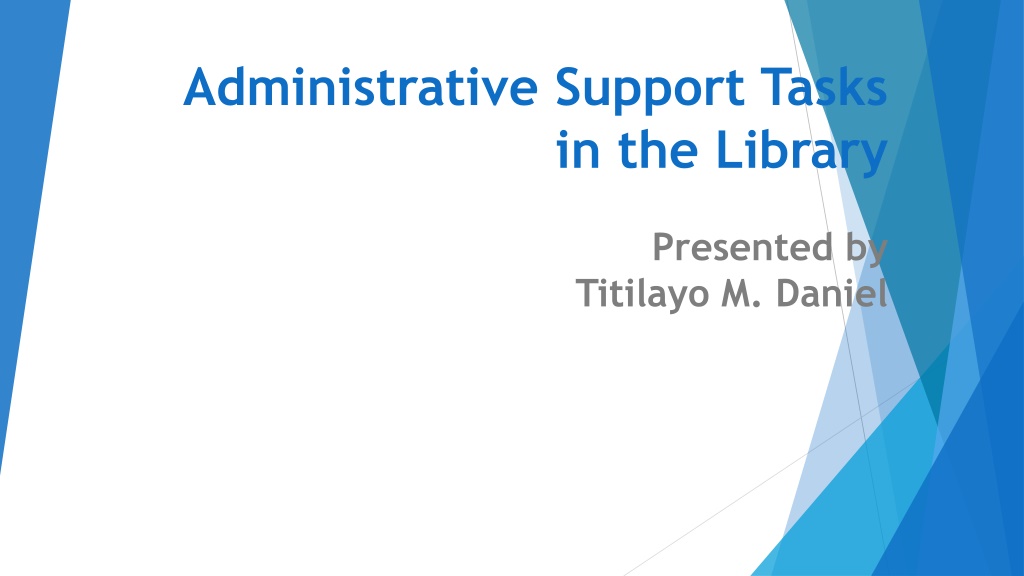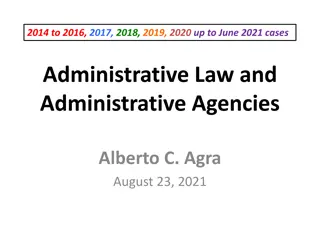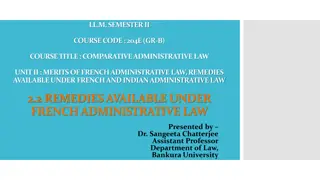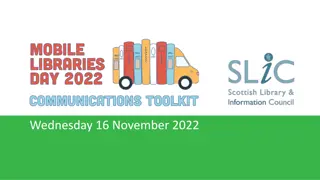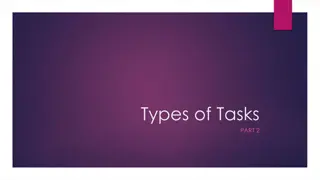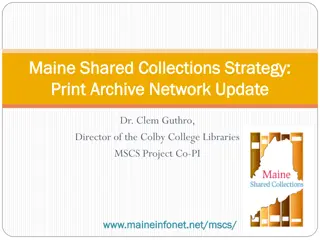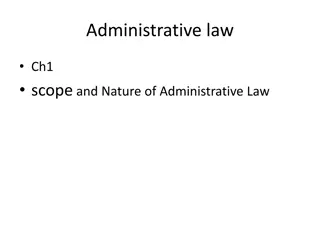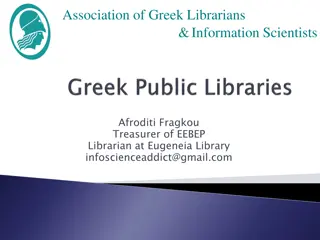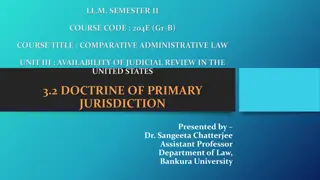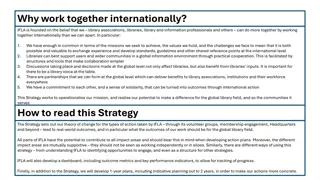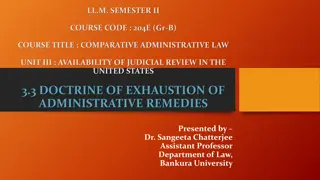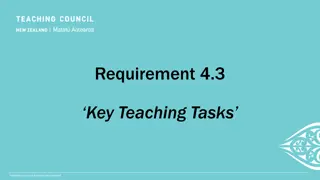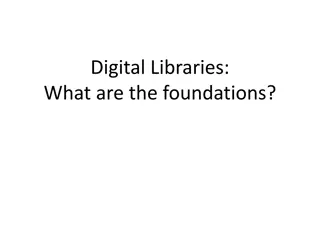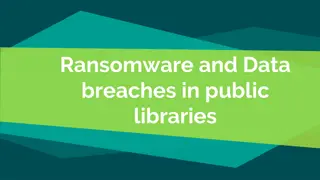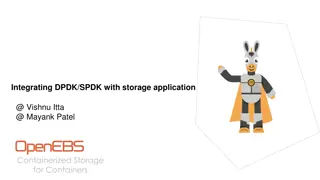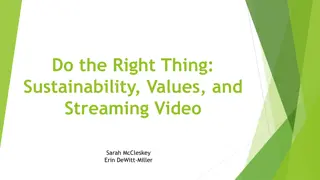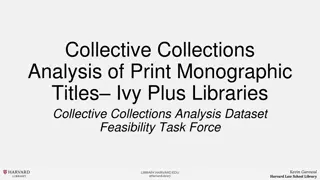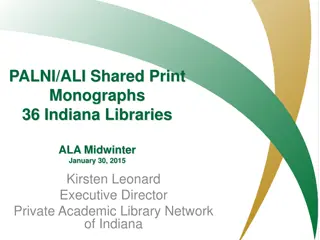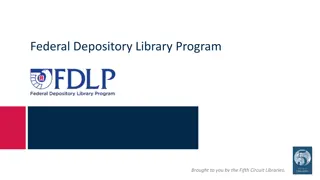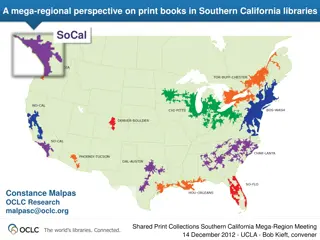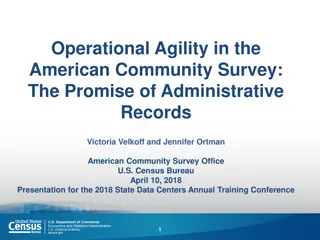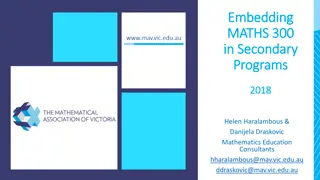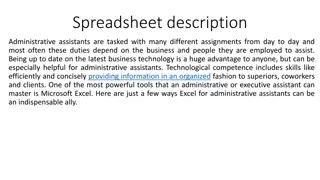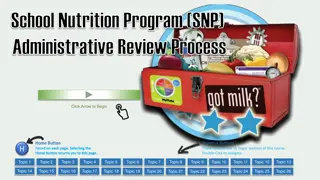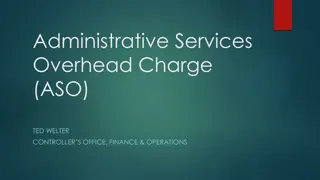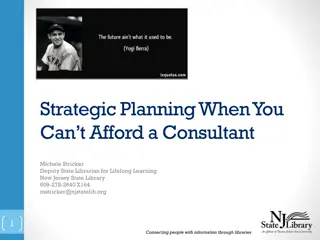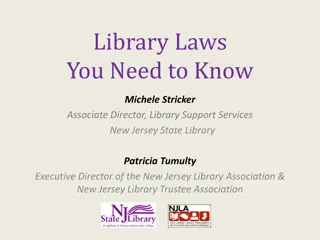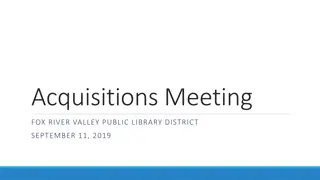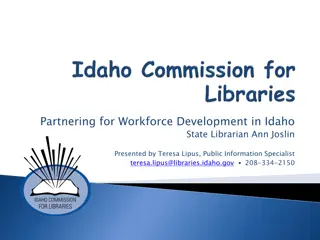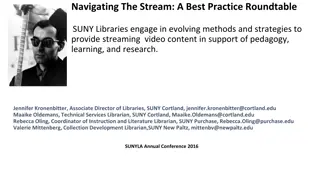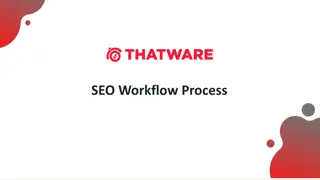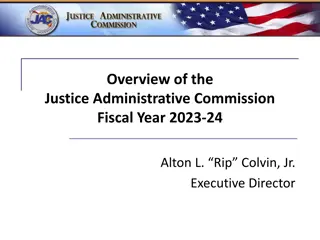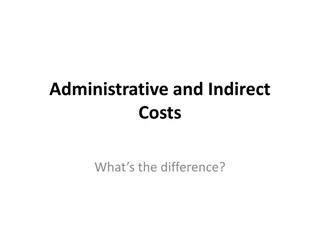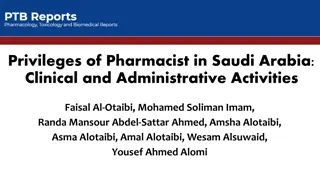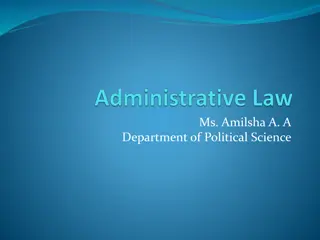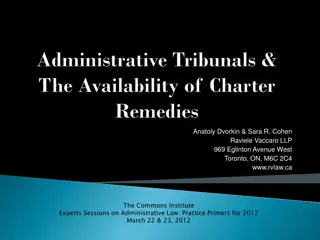Effective Administrative Support Tasks in Libraries
This training equips library staff with skills to handle administrative tasks effectively, covering memo writing, file organization, exhibition promotion, time management, and inventory management. Participants learn to prioritize tasks, communicate efficiently through memos, and maintain organized files for improved productivity. The focus is on enhancing the support provided to library staff and users.
Download Presentation

Please find below an Image/Link to download the presentation.
The content on the website is provided AS IS for your information and personal use only. It may not be sold, licensed, or shared on other websites without obtaining consent from the author. Download presentation by click this link. If you encounter any issues during the download, it is possible that the publisher has removed the file from their server.
E N D
Presentation Transcript
Administrative Support Tasks in the Library Presented by Titilayo M. Daniel
Administrative Support Tasks in the Library This training aims to equip library staff with the necessary skills and knowledge to handle administration and support tasks within the library effectively. Participants will understand key administrative responsibilities and learn practical strategies for providing excellent support to library staff and users.
Overview Memo Writing Organization of files Exhibition and Library Promotion Time Management and prioritization Inventory Management
Memo Writing Memorandum, commonly known as a memo, is a concise and effective communication within emails or formal reports, memos are brief and straight to-the-point documents designed for quick dissemination of information to a specific audience within the Institute. As a vital tool in professional communication, mastering the art of memo writing is crucial for conveying updates, or directives in a clear and efficient manner. means organization. of internal Unlike an important messages,
Memo Writing Format in NILDS NATIONAL INSTITUTE FOR LEGISLATIVE & DEMOCRATIC STUDIES NATIONAL ASSEMBLY INTERNAL MEMO To: From: Date: Subject: Sender
Organization of files The organization of files refers to the systematic arrangement and structuring of digital or physical documents, data, or information in a manner that facilitates efficient storage, retrieval, and management. Whether in a digital environment on a computer or in a physical filing cabinet, the organization of files is essential for maintaining order, enabling quick access, and enhancing overall productivity.
Organization of files cont. Physical file organization involves arranging paper documents in a systematic way within folders and filing cabinets. This organization ensures that documents are easy to find and retrieve when necessary, contributing to a more efficient and functional office or personal space. In the library, our physical files are arranged alphabetically (A-Z), with corresponding titles. Most used file tags to note are: Incoming Memo , ISBN/ISSN, Outgoing Memo ( acknowledged copy), PG School and Workplan
Organization of files cont. In a digital context, file organization typically involves creating a logical folder structure, using descriptive file names, and employing consistent naming conventions. This will help you keep track of your documents, photos, spreadsheets, and other files, making it easier to locate specific items when needed. Effective digital file organization contributes to streamlined workflows, minimizes the risk of data loss, and promotes collaboration, especially in shared or team environments. On your PCs, it is important that your work are also arranged in folders so that in your absence, someone else can easily retrieve documents.
Exhibition and Library Promotion library exhibition refers to a curated display of materials and information resources. These exhibitions are designed to showcase specific themes, collections, or topics of interest, providing library visitors with a unique and immersive experience. Library exhibitions can take various forms, incorporating a range of media, such as books, manuscripts, photographs, etc. Exhibitions provide a unique opportunity to showcase collections and attract a wider audience. By strategically planning, promoting, and engaging the community, NILDS library have turn exhibitions into dynamic experiences that not only showcase our collections but also strengthen our role as vital intellectual hub.
Exhibition and Library Promotion Cont. Key features of Library exhibitions Thematic Focus: Exhibitions are often organized around a specific theme, historical period, cultural topic, or subject matter relevant to the library's collection or community interests. Educational Purpose: Library exhibitions serve an educational function by providing context, historical background, and additional information related to the displayed materials. This educational aspect aims to inform and engage visitors in a deeper understanding of the exhibition's subject matter. Community Engagement: Exhibitions often attract a diverse audience, including library patrons, students, researchers, and the general public.
Exhibition and Library Promotion Cont. Promotion of Library Collections: Exhibitions are an effective way for libraries to highlight specific collections, draw attention to lesser-known materials, and promote the diverse resources available within the library. Curation and Design: Library exhibitions involve careful curation and thoughtful design to create a visually appealing and informative experience. The arrangement of items, use of signage, and incorporation of multimedia elements contribute to the overall impact of the exhibition. Library exhibitions play a crucial role in enriching the cultural and intellectual life of the community. They contribute to the library's mission of promoting education, fostering a love of learning, and preserving and sharing valuable cultural and historical resources.
Time Management and prioritization Library time management refers to the strategic planning and efficient use of time within a library setting to ensure that resources, staff, and services are utilized effectively. This includes organizing tasks, schedules, and workflows in a way that optimizes productivity, enhances service delivery, and meets the needs of library patrons. Effective library time management involves various aspects, such as staff scheduling, prioritization of tasks, streamlined processes, and the integration of technology. Effective time management is crucial for maintaining the smooth operation of a library, ensuring that resources are utilized efficiently, and providing patrons with a positive experience.
Time Management and prioritization Cont. How to manage your time effectively at work: Task Allocation: each staff is in different units as such each job description Delegate Responsibilities: Assign specific tasks and responsibilities to staff members based on their skills and expertise Prioritization of Tasks: Determine tasks that require immediate attention, such as responding to patron inquiries, processing returned materials and processing new arrivals.
Library Inventory Management Library inventory management is the systematic process of overseeing and controlling the materials and resources within a library's collection. It involves organizing, tracking, and maintaining accurate records of the library's holdings, which can include books, periodicals, multimedia materials, digital resources, and other items. The primary goal of library inventory management is to ensure that the library's collection is well-organized, up-to- date, and easily accessible to patrons. Effective library inventory management ensures that the library's resources are well-maintained, easily accessible, and aligned with the needs and interests of the community it serves. The most popular form of inventory in NILDS library is accessioning. Accessioning involves the formal process of recording and assigning number to new materials in order of their arrival to the library.
Library Inventory Management Cont. Organized Collection: Accessioning ensures that every new item added to the library is properly cataloged and assigned a unique identifier. Efficient Retrieval: Having a well-accessioned collection streamlines the retrieval process. Patrons can find materials quickly using the library's catalog Inventory Control: Accessioning helps maintain an accurate inventory of the library's holdings. Regular updates to the catalog ensure that the collection reflects the current state of available resources, reducing the risk of lost or misplaced items. In summary, accessioning is a foundational process that brings order to a library's collection, enhances user access to information, supports efficient library operations, and contributes to long-term planning and development. It plays a vital role in ensuring that the library remains a valuable and organized resource for its community.
Conclusion As library staff, each one of you plays a pivotal role in shaping the patron experience, fostering a culture of learning, and maintaining the library as a hub of knowledge and engagement. It is important to note that every work in the library is important. From guiding patrons through resources, going for exhibitions, or contributing to the seamless functioning of administrative tasks, your role is pivotal in shaping the library's impact. It is therefore essential that you apply the knowledge you ve gained from this training to create a welcoming work environment for your colleagues and library users as well. Thank You!!!!!!!!!!!!!
